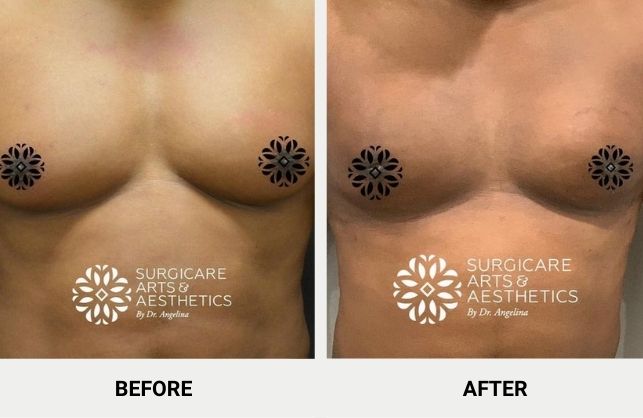One of the most embarrassing conditions that men can experience is gynecomastia. When it occurs, men do not always know if they have excess fat deposits on their chest known as pseudo gynecomastia or if they have a glandular condition (gynecomastia) because at first glance they look quite similar. There are a few signs that can help differentiate between the two and there are ways to eliminate both.
What Is Gynecomastia?
Gynecomastia is a condition that has also been referred to as “man boobs” and is characterized by excess tissue on a man’s chest that gives him the appearance of having breasts. It is a condition that often causes men to feel self-conscious about taking off their shirts at the pool, beach, or even in front of their significant other.
There are different factors that can contribute to the occurrence of gynecomastia and they are not related to being overweight. If a man has the appearance of breasts due to his weight, this condition is called pseudogynecomastia or fatty gynecomastia.
What Causes Gynecomastia?
In true cases of gynecomastia also called glandular gynecomastia, excess glandular male breast tissue is produced due to an imbalance of hormone levels.
It is often believed that androgens (like testosterone) are male hormones and that estrogen is a female hormone but the truth is that both men and women have both hormones naturally occurring in their bodies. The difference between the hormones in men and women is the level of each hormone present.
Testosterone is the predominant hormone in a man and estrogen is more dominant in women. When a man’s hormonal balance shifts and an increase in estrogen is experienced or a significant decrease in testosterone happens, this can result can in gynecomastia.
Causes of Male Hormone Imbalance Resulting in Gynecomastia
- Puberty – gynecomastia often occurs during puberty due to the normal but large swings in hormone levels that manifest between the ages of 13 and 14 but have been known to occur in boys as young as 10. Most instances of gynecomastia that happen during puberty normally resolve without any medical treatment necessary. For about 25% of these individuals, the condition persists into adulthood.
- Medication, drugs – gynecomastia can develop as a side effect of certain medications that are used for conditions such as high blood pressure, heart failure, and certain infections. It can also be a by-product of steroid use or the use of illegal drugs.
What Is Pseudogynecomastia?
Some men experience what is known as fatty gynecomastia or pseudogynecomastia due to weight gain. Each person has areas of their body where they gain their excess weight and for these men, excess fat cells collect in the chest area giving them the appearance of female breasts.
In some instances distinguishing between mild gynecomastia vs fat can be tricky. They can both produce similar-looking results but gynecomastia will not respond to working out or losing weight.
Sometimes fatty gynecomastia responds to diet and exercise but this is not the case for everyone and despite their best efforts there is no change to their chest area.
Pseudogynecomastia vs Gynecomastia
It can be confusing to tell the difference between gynecomastia and pseudogynecomastia because at first glance they can look the same.
The best and most accurate way to determine between excess chest fat vs gynecomastia would be through a consultation with your doctor, but there are a few things to look for that may give you an idea of what you are dealing with.
Tips to Know If You Have Gynecomastia or Just Fat
1. Response to Diet and Exercise
Glandular gynecomastia is true breast tissue that is fibrous and firm and does not respond to diet and exercise. While pseudo-gynecomastia causes fat cells in the pectoral area to become enlarged and excess chest fat normally will respond to physical work-outs and dieting.
A known side effect of obesity is the production of excess estrogen so a man may have both glandular and fatty gynecomastia at the same time, but until a significant weight loss is achieved the glandular gynecomastia is undetected.
2. Glandular and Fatty Gynecomastia Feel Different
Fatty gynecomastia will usually feel the same as excess stomach fat which is soft to the touch and a bit jiggly. Glandular gynecomastia feels much firmer or somewhat rubbery. A hard firm lump that can be felt under the nipple area is a good indication that gynecomastia is present.
3. Presence of Pain
Gynecomastia often causes mild to moderate pain and tenderness in the “breast” area and the area may also appear swollen. Excess chest fat does not normally produce any pain or swelling.
4. Appearance
Fatty gynecomastia and glandular gynecomastia can look slightly different. Excess fat that develops on a man’s chest usually looks saggy and is not a defined shape. Glandular gynecomastia presents more like female breasts; rounded and proportioned and sometimes the nipple area protrudes further out from the chest.
Treating Glandular Gynecomastia and Fatty Gynecomastia
Sometimes, such as in adolescent boys, gynecomastia will clear up on its own however, it normally requires surgical intervention.
Luckily, the amazing advancements that have been achieved in the area of cosmetic surgery have made it possible to effectively treat either condition safely and efficiently.
Gynecomastia may require the surgical removal of some firm glandular tissue from under the nipple area through an incision made just under the areola. In many instances, the use of liposuction will also be required to properly contour the chest area and achieve a more masculine-looking physique.
Liposuction can be performed using one of several available techniques but usually, a thin tube (cannula) is used to vacuum fat out from the targeted area. Some techniques utilize cosmetic procedures that remove unwanted fat and tighten the skin in one treatment, e.g. Vaser liposuction and BodyTite.

In more severe cases, it is often necessary to treat both conditions at the same time. If a significant amount of tissue is removed it may be necessary to reposition the nipple or areola during surgery to create more natural-looking results.
Recovery from Gynecomastia Treatment
Recovery from gynecomastia or pseudo gynecomastia treatment will vary depending on the extent of surgery and procedures used to achieve the desired results.
Usually, there are only two small incisions made to perform the liposuction and extraction of any excess glandular tissue and any resulting scars will be well hidden under the arm and around the areola.
Patients will wear a compression garment after the procedure to help mitigate swelling according to the instructions provided to them by their surgeon. Aftercare may also include properly taking care of the incision sites as instructed.
Some patients are back to their normal routines in just a few days while others recover in about two weeks. The timeframe to return to your activities will depend on the extent of your treatment.
If you are self-conscious about your chest due to the appearance of man boobs (gynecomastia), the condition is common and you are not alone! A quick consultation with Dr. Angelina Postoev, a triple-board certified cosmetic surgeon can help clear up any confusion between gynecomastia vs fat tissue and answer any questions you may have. There are many effective and safe options for treatment to help eliminate this common condition and boost your self-image.
Contact IBI Plastic Surgery & Med Spa , a division of IBI HealthCare Institute for a consultation today. Angelina Postoev, MD, FACS, a triple-board certified cosmetic surgeon, and Christopher Ibikunle, MD, FACS, offer gynecomastia surgery for men in Lawrenceville, Suwanee, Johns Creek, Buckhead, Duluth, and the surrounding areas of Georgia as well as Florida (Tampa and Hudson areas).







